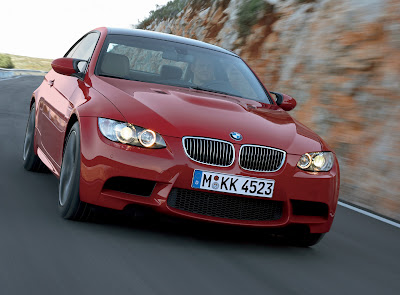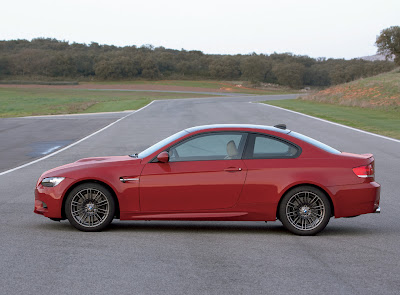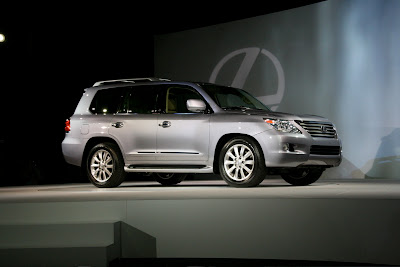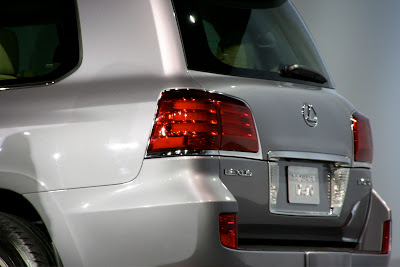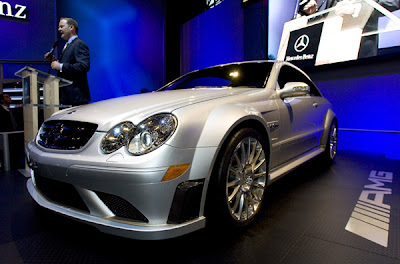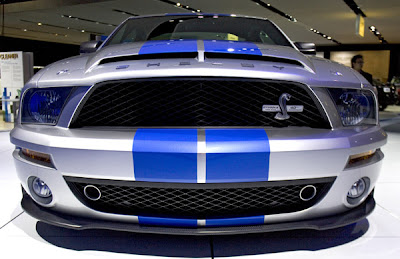



PRESS RELEASE:
The
new BMW M3.
Description in Brief.
• Fourth-generation of the
BMW M3, all-new, unique
high-performance sports car from
BMW M GmbH with unprecedented design and technology, developed on the basis of the
BMW 3 Series Coupé.
• Unique character and supreme driving dynamics secure leading position in the market segment, unique combination of engine power and low weight ensured by intelligent lightweight technology, power-to-weight ratio 3.8 kg/hp.
• First-ever
BMW M3 with an
eight-cylinder power unit, all-new
V8 displacing 4.0 litres and developing maximum output of 309 kW/420 hp plus peak torque of 400 Nm/295 lb-ft at 3,900 rpm, maximum engine speed 8,400 rpm, optimum power and torque throughout the entire engine speed range.
• Individual throttle butterflies, variable
double-VANOS camshaft control,
Brake Energy Regeneration, engine weight 15 kg/33 lb less than the six-cylinder in the former model.
• Acceleration to 100 km/h in 4.8 seconds, top speed limited electronically to 250 km/h (155 mph), average fuel consumption in the EU test cycle 12.4 litres/100 kilometres (equal to 22.8 mpg Imp).
•
Manual six-speed gearbox with integrated, temperature-related oil cooling, mass inertia-optimised double-plate clutch.
•
MDrive for setting and retrieving the driver's specific configuration of the engine control map, suspension and
DSC set-up, as well as the
Servotronic control map as an additional option.
• All-new suspension with special, weight-optimised components as well as axle kinematics characteristic of
BMW M for a highly dynamic driving experience, forged aluminium track control arms, compound high-performance
brake system, optional
Electronic Damper Control (EDC) with three freely available control maps.
• First production vehicle in its segment with carbon-fibre-reinforced roof, carbon fibre serving to reduce the weight of the vehicle and enhance agility by lowering the centre of gravity, carbon-fibre roof in visible technology symbolising exclusivity and a direct link to motorsport.
• Authentic
BMW M design underlining the athletic look of the car, aluminium engine compartment lid with a striking powerdome as a clear signal of supreme power and performance, characteristic front end with large air intake scoops, muscular, powerfully flared wheel arches.
• Air intake gills in the front side panels,
M-specific side-sills accentuating the concept of rear-wheel drive, discreet spoiler lip reducing lift forces at the rear, roof in clearly visible carbon-fibre look, dual tailpipes typical of
BMW M.
• High-quality, sophisticated and perfectly appointed interior with a wide range of customisation, innovative colour and materials concept, four seats,
BMW Individual high-end audio system tailored to the car as an option, model-specific paintwork and equipment variants highlighting the exclusivity of the
new BMW M3.
Turning Powerful
Passion into Supreme Performance:
The new BMW M3.
Entering each new season in motorsport, we feel new and fresh ambition, query formally proven recipes for success, and focus on new records and outstanding achievements. And precisely this also applies to the debut of the
new BMW M3: Having completed its test cycle with flying colours, the
new high-performance sports car from
BMW M GmbH is ready and waiting to take over pole position. Indeed, with its superior power, performance and dynamism, the
new BMW M3 ensures truly unique sheer driving pleasure of the highest calibre.
The new, 309 kW/420 hp
V8 power unit offers enormous muscle and performance at all times. And the aesthetic design of the new car typical once again of
BMW M spells out supremacy of the highest standard.
The
new BMW M3 sets the foundation for continuing an exceptional career in motorsport. So every enthusiast sharing the passion for supreme performance may be sure that this model is able to master even the greatest challenge on and off the race track. And last but certainly not least, the
new BMW M3 offers the supreme standard of reliability and everyday driving qualities so typical of all high-performance cars from
BMW M GmbH.
The all-new "heart" of the latest
BMW M3 is the
eight-cylinder power unit which, through its
high-speed engine concept alone, comes with all the
DNA of the current
Formula 1 engine raced by the
BMW Sauber F1 Team. Applying this high-speed concept characteristic of all
BMW M power units, the
new V8 develops maximum output of 309 kW/420 hp from engine capacity of precisely 3,999 cc. Further equally impressive factors are the engine's peak torque of 400 Newton-metres or 295 lb-ft as well as maximum engine speed of 8, 400 rpm.
Truly unprecedented, however, is the thrust and pulling force generated through this unique potential, conveying the supreme power of the engine through the
variable M differential lock to the rear wheels. Precisely this is why the
new BMW M3 is not only outstandingly responsive in its acceleration, but also completely shattering in the way it develops its power: Acceleration to 100 km/h comes in just 4.8 seconds, and the car continues this mind-boggling performance with fascinating consistency all the way to its top speed of 250 km/h or 155 mph, where the engine electronics set an artificial limit to the ongoing power and performance of the
new BMW M3.
Brand-new in technology and design.
Within the
BMW M GmbH model range, the
BMW M3 has always been that very
special model living up in full to its motorsport heritage. Indeed, this already applied to the very first
BMW M3 launched in 1986 and continued throughout the two subsequent model generations. And now this supremacy comes out once again most clearly in the
2007 version of the
BMW M3.
Although the latest generation of the
BMW M3 was based in its development on the
new BMW M3 Coupé, the
new high-performance model differs from the "regular" coupé in terms of both looks and technical features. Apart from the car's unique design as well as its drivetrain and suspension technology conceived from the start for supreme performance, lightweight technology came right at the top in the brief given to the engineers at
BMW M. And just how consistently this development target has been translated into reality in terms of intelligent lightweight engineering is borne out by the car's power-to-weight ratio of only 3.8 kg (8.4 lb) per horsepower.
One of the reasons for this low weight is that the
new BMW M3 is the first production car in its segment to boast a roof made of carbon-fibre-reinforced plastic (CFP). And in all, the
new BMW M3, with the exception of just a few components, is indeed completely new in its engineering and design concept, clearly reflecting the successful tradition of
BMW M GmbH.
Apart from the load-bearing structure of the car, only the two doors, the bootlid, the windows, the headlights and rear lights have been carried over from the
3 Series Coupé. All other body components, by contrast, were specially developed for the
new BMW M3.
The unique character of the
new BMW M3 is obvious at first sight: Over and above the engine compartment lid with its striking powerdome and the two air intake openings, the function-oriented design of the front and rear air dams, the so-called gills in the front side panels, the side-sills also in distinctive design, the roof made of clearly visible carbon fibre, as well as the exterior mirrors and light-alloy wheels in
BMW M design clearly characterise the new model from the ground up. The exterior, in turn, through its athletic and aesthetic appearance, powerfully underlines the sporting qualities of the car.
The exterior paintwork likewise adds an individual touch, offering the connoisseur not only numerous additional colours, but also four special paintwork options exclusive to
BMW M.
The interior: tailor-made for optimum driving pleasure.
In designing the interior, the specialists at
BMW M GmbH have succeeded in offering the occupants maximum driving pleasure in an ambience tailored to their specific needs and wishes. This applies particularly to the driver, with all controls and instruments relating directly to the active driving experience in the car adapted to the supreme performance of the
BMW M3 and re-designed from the ground up wherever appropriate.
Double circular instruments with white illumination and red needles, the
M leather steering wheel and the newly designed centre console all characterise the cockpit of the
new BMW M3. The door cutout trim embellished by the characteristic M logo, the support for the driver's left foot made of brushed metal, the special design and colour of the inner door panels, as well as the trim strip made of high-quality, sophisticated materials exclusive to
BMW M such as leather in carbon design or aluminium, all serve to underline the supreme and truly unique position of the
new BMW M3.
The first-ever
eight-cylinder to power a
BMW M3.
After 15 glorious years in the world of motoring, the straight-six power unit lauded time and again as the
Engine-of-the-Year in the two former model generations of the
BMW M3 is now giving way to a truly worthy successor: The
new BMW M3 comes for the first time with an
eight-cylinder power unit. And the specifications of this
all-new high-performance engine clearly prove the competence and skill of the engine development specialists at
BMW M GmbH gained in a long history of racing success: Displacing 3,999 cc, the
new V8 develops maximum output of 309 kW/420 hp, together with peak torque of 400 Newton-metres or 295 lb-ft at 3, 900 rpm. Perhaps an even more outstanding fact is that some 85 per cent of the engine's peak torque remains available throughout the enormous speed range of 6, 500 rpm.
The
eight-cylinder nevertheless owes its most striking and distinctive forte to the
high-speed engine concept so typical of
BMW M: Revving all the way to 8,400 rpm, the new power unit offers supreme muscle and performance at all times. Power is transmitted to the rear wheels by a
six-speed manual gearbox interacting with brand-new final drive. This combination alone provides an acceleration and power potential reminiscent in its spontaneity and endurance to the dynamic potential of a thoroughbred
racing car.
Over and above specific output of 105 hp per litre, average fuel consumption in the
EU test cycle of 12.4 litres/100 km (equal to 22.8 mpg Imp) offers a clear expression of the engineering skill so characteristic of the engine specialists at
BMW M GmbH.
Weighing a mere 202 kg (445 lb), the
V8 power unit featured in the
new BMW M3 is a genuine lightweight. Even compared with the
six-cylinder power unit in the former model, engine weight is down by some 15 kg or 33 lb.
Production of components using know-how carried over from
Formula 1.
The
engine block featured on the
new eight-cylinder comes from
BMW's light-alloy foundry in Landshut near Munich, which also builds the
engine blocks for the supreme racing machines entered in
Formula 1 by BMW Sauber. The crankcase is made of a special aluminium/silicon alloy eliminating the need for conventional cylinder liners, since the cylinder surface is formed instead by exposing the hard silicon crystals integrated in the alloy. The iron-coated pistons thus run directly in these uncoated, honed cylinder bores.
With the high speed of the engine and high compression forces obviously exerting extreme loads on the crankcase, the crankcase is compact and particularly stiff in its bedplate structure, ensuring very exact support of the crankshaft. Made as a complete forging, the crankshaft is very stable in terms of flexural and torsional stiffness, but nevertheless weighs a mere 20 kg or approximately 44 lb.
Valve control by
double -VANOS operating at low oil pressure.
The
V8 power unit of the
new BMW M3 features
BMW's variable
double-VANOS camshaft control. Keeping valve timing extremely short and quick, this superior technology reduces charge cycle losses and, in the process, improves engine output, torque and responsiveness, with an equally positive impact on both fuel economy and emissions.
A low-pressure version of
BMW's double-VANOS has been developed especially for the
new eight-cylinder, ensuring extremely fast valve timing even under normal engine oil pressure.
A separate throttle butterfly for each cylinder is the most supreme and sophisticated technology not only on racing engines when it comes to providing immediate engine response. So precisely this is why the
new power unit on the
BMW M3 comes with eight individual throttle butterflies, two actuators operating four butterflies on each row of cylinders to provide particularly smooth engine repose at low speeds combined with an immediate reaction whenever the driver requires supreme engine power and equally supreme performance.
Two
volume flow-controlled pendulum-slide-cell pumps supply the
eight-cylinder with sufficient lubricant at all times, delivering precisely the amount of oil the engine requires under current running conditions. Wet sump lubrication optimised for driving dynamics ensures a reliable supply of oil even in an extreme brake manoeuvre, with the system combining two oil sumps with one another – a small oil sump in front of the front axle subframe and a large oil sump further behind. A separate oil reflow pump extracts oil from the front oil sump and delivers it to the rear sump again in a smooth process geared to current requirements.
New engine management and
Brake Energy Regeneration.
The electronic management of the
V8 power unit coordinating all engine functions with optimum efficiency and precision, is yet another new development. A further point is that the control unit masterminds all the
M-specific functions of the clutch, transmission, steering, and brakes.
And last but not least, the engine control unit performs a wide range of on-board diagnostic functions, as well as other control operations involving, say, various ancillary units on the engine.
A particular highlight in engine management is ion flow technology serving to detect the risk of the engine knocking as well as mis-firing and mis-combustion. Contrary to conventional technologies, this new technology monitors the engine and performs its function precisely where things count most, that is within the combustion chamber. To do this, each cylinder is checked via the spark plug for any possible knocking, and is then controlled accordingly. At the same time the system checks the ignition and recognises any mis-firing, the spark plug thus serving as an actuator for the ignition and as a sensor monitoring the combustion process. In this way the spark plug is able to distinguish between mis-combustion and mis-firing, also facilitating the process of engine diagnosis for highly efficient service and maintenance through its dual function.
Intelligent energy management featuring
Brake Energy Regeneration likewise serves to further enhance the efficiency of the
V8 power unit in the
new BMW M3. In this case the power required for the on-board network is generated specifically during overrun and during application of the brakes, serving to charge the car's battery at exactly the right time without taking up any of the energy contained in the car's fuel. As long as the engine is "pulling" the car, therefore, the alternator generally remains disengaged. Apart from particularly efficient generation of electric power, this also serves to provide more drive power and traction for supreme acceleration at all times.
Aluminium suspension for driving pleasure of the highest standard.
Smoothly and efficiently sharing out steering and drive forces on the front and rear axle, the chassis and suspension of the
new BMW M3 provides the ideal foundation right from the start for particularly dynamic performance and driving characteristics. The chassis of the
new BMW M3 is indeed a brand-new development from the ground up, seeking to cope from the start with the significant increase in drive power and save a lot of weight in the process.
Precisely this is why nearly all components on the newly developed front axle are made of aluminium, among them the spring struts even stiffer than before, the swivel bearings, the central subframe and an additional thrust plate enhancing crosswise stability of the entire front section. Indeed, the engineers at
BMW GmbH have even succeeded in saving additional weight on the
high-performance brake system with its compound brake discs.The five-arm rear axle of the
BMW M3 in lightweight technology is also a brand-new construction from the ground up, with the exception of one single track control arm. The particular design and construction of all aluminium arms in forging technology, in conjunction with the aluminium dampers, serves to reduce weight on this part of the car alone by 2.5 kg or 5.5 lb.
Anti-roll bars optimised for their function and minimum weight are featured both front and rear. The change in axle geometry in both cases – featuring two additional longitudinal bars, apart from other new or modified components – offers new axle kinematics tailored to the high power of the car and its particularly sporting and dynamic overall character.
The
new final drive on the
BMW M3 comes complete with a
Variable M Differential Lock providing up to 100 per cent locking action in a completely variable process whenever required and thus ensuring optimum traction on all surfaces. Responding to differences in speed between the right and left rear wheel, the
Variable M Differential Lock also offers ideal support further enhancing the positive features and characteristics of rear-wheel drive.
The result of these many improvements on the chassis and suspension also comes out clearly on the race track, the
new BMW M3 significantly outperforming the lap times of all model generations on the Nordschleife of Nürburgring, where all
BMW M Cars are put through their paces for their ultimate test.
MDrive button for the ambitious driving enthusiast.
Enjoying the qualities of the
new BMW M3, the driver is able to configure several driving parameters indivdually according to his particular requirements, thus adjusting the car's behaviour and performance to his personal preferences. One option, for example, is to completely deactivate the
Dynamic Stability Control (DSC) via the car's set-up.
Electronic Damper Control (EDC), in turn, which optimises both vertical vibration behaviour as well as the car's dive and roll in bends and when applying the brakes and accelerating by adjusting damper forces, comes with three different settings – Normal, Comfort, and Sports – the driver is able to pre-select at the touch of a button.
Three control maps are also available for precise, on-demand management of the engine. These management functions operate not only on the position of the throttle butterflies in the intake manifold, but also on further factors and parameters significantly changing the behaviour and response of the engine.
The optionally available
MDrive configuration enables the driver to pre-select the response of the
Servotronic power steering. In the process,
MDrive is able to follow two control maps varying steering forces between the Normal and Sports setting as a function of road speed.
Athletic body design as a visible expression of superior power.
The exterior of the
new BMW M3 was designed and developed from the start to give the car a truly unique and sporting look. So applying the principle of "form follows function", the designers at
BMW M GmbH, in giving the body of the car its particular look and appearance, have succeeded in finding a perfect match of supreme technology, on the one hand, and authentic sporting design, on the other.
Reflecting this clear-cut principle, the engine compartment lid made of aluminium features an impressive powerdome right in the middle.
Together with the recesses right next to the powerdome providing space for additional air intake openings, this special design feature clearly hints to the supreme potential of the eight-cylinder power unit within the engine compartment. The contours of the powerdome and air intakes follow the forward-pointing arrow shape of the engine compartment lid, blending harmoniously into the overall design of the front end even longer than on the "regular"
BMW 3 Series Coupé.
Front end designed for maximum air intake.
The front end of the car boasts three large air intake scoops beneath the radiator grille serving to feed intake and cooling air to the engine. The air intake scoops border on either side on large, vertical bars and further enhance the characteristic design language of the car. Together with the double kidney grille so typical of
BMW and the low-slung headlight units with their xenon main beams, the air intakes give the
new BMW M3 a highly dynamic appearance right from the start.
Primarily, however, the particular design and structure of the front end is determined by the supply of air required for the high-performance power unit: Almost the entire front end opens up to supply the naturally aspirated engine with a sufficient flow of air. So it is only consistent that the
new BMW M3, like
BMW M Cars in general, does without the foglamps so characteristic of the "regular" models in the range. In their function and size, all the air intakes are precisely defined according to technical requirements. Their arrangement and dimensions are geared precisely to the cooling and intake air required by the engine and its ancillary units.
Light and shade effects creating a firm and taut side-line.
The powerfully chiselled front wheel arches on the
new BMW M3 stand out clearly as a symbol of supreme agility and driving stability. Together with the weight-optimised
18-inch light-alloy wheels in
double-spoke design again so typical of a
BMW M, the wheel arches accentuate the particularly wide track of the car.
Forged light-alloy wheels measuring 19 inches are available as an option.
And looking through the spokes of the wheels, regardless of the version chosen, the beholder will immediately admire the compound high-performance brakes developed exclusively for
BMW M Cars.
Both front side panels come with a particular sign of distinction to be seen only on a
BMW M Car – the air intake "gills", as they are called by the designers. The elaborately modelled contours of the car highlight the course of the profile line extending back along the side. The chrome trim distinguishing between the various sections, in turn, further enhances the three-dimensional structure of this particular element, accommodating both the long and sweeping direction indicator as well as the
M3 logo.
The exterior mirrors developed exclusively for the
new BMW M3 also serve to enhance the car's aerodynamic qualities. The most characteristic feature on the mirrors is the double arm finished in black and reminiscent in its design of the wings of an aircraft. Through their horizontal contour edge and their particular shape narrowing to the outside, the exterior mirrors not only accentuate the sporting look of the car, but also help to reduce air drag thanks to their particular shape optimised in the wind tunnel.
Two surface elements literally twisting around one another form the significantly flared side-sills and generate a smooth but interchanging flow of light serving to give the car an even lighter and more sporting look from this angle by making the side panels look even lower. In their design, the side-sills correspond with the particular shape and appearance of the clearly contoured profile line along the body. A further point is that the distinctive contrast of light and shade generates a feeling of tension on the likewise muscular, widely flared side panels and the wheels beneath, thus giving particular emphasis to the significance of rear-wheel drive in the outstanding performance it gives the
new BMW M3.
Discreet spoiler lip and rear diffuser for optimum aerodynamics.
Seen from the rear, the
new BMW M3 again boasts superior and powerful proportions. At the same time the rear end design of the car takes up the characteristic look of the front end, the side-line moving down smoothly and gently and the rear wings extending into a carefully chiselled concave panel underlining the concept of rear-wheel drive and visualising the superior dynamics of the car.
A discreet spoiler lip on the lid of the luggage compartment also referred to in racing terms as the "Gurney Flap" optimises the streamlining of the
new BMW M3 and serves to further reduce lift forces at the rear.
The contours of the diffuser split up into individual sections by carefully modelled bars beneath the rear bumper again takes up the shape and design of the air intakes at the front. The air flow duct and the dual tailpipe moved far towards the centreline of the car appear to visually contract the rear end in the lower middle section, building up a feeling of superior tension in the eyes of the beholder extending all the way to the horizontally flowing lines of the bumper.
As yet another feature typical of
BMW M Cars, the four tailpipes are circular in shape and cut off in a straight line at the rear, giving the rear end an even more muscular stance and again focusing the beholder's attention on the powerful wheels of the car.
Roof in high-tech carbon-fibre: low weight, big effect.
Carbon-fibre has made its way successfully into
Formula 1 as an extremely stable, but nevertheless very light material. So it is only consistent for the designers and engineers responsible for the
new BMW M3 to use precisely this material originally applied in aerospace in order to further lower the centre of gravity of the
new BMW M3 – carbon-fibre-reinforced plastic (CFP) is used where it counts most, on the outer skin of the car, saving about 5 kg or 11 lb in the process. With this weight being saved at the highest point on the body, the effect on driving dynamics is of course particularly positive.
To enhance the high-tech character of the car also in visual terms, the roof is finished only in clear paint, thus proudly maintaining and demonstrating the woven structure of the carbon fibre. A further point is that the dark look of the roof makes the roof pillars look even lower from the side, creating the impression as if the entire car were resting in an even lower and more dynamic position on the road.
The production technology developed especially for the CFP roof is currently applied exclusively by
BMW's specialists at the Company's plant in Landshut just north of Munich. Originally, this technology was developed for the production of very special cars built in limited editions for the most demanding connoisseurs. And now, thanks to the unique know-how of
BMW's production engineers at the Landshut Plant, new ways and means of using and processing CFP have been developed, opening up the door to the use of this material in far larger numbers, for example on the roof of the
new BMW M3.
Special
M body colours adding a further touch of exclusivity.
The
new BMW M3 is available with a choice of no less than four M metallic paintwork options giving particular emphasis to the interaction of the body surfaces, the contours and proportions of the car. Coming with a light shimmering effect, Melbourne Red, for example, combines unique brilliance and colour depth. Jerez Black, on the other hand, boasts blue pearl pigments to again provide unique highlights and unprecedented appeal. Powerful Interlagos Blue, in turn, incorporates red colour pigments to provide a highly attractive interaction of blue and violet from various angles.
The fourth colour already well known from the
BMW M5 and
BMW M6 is Silverstone, a light silver colour with a slight touch of blue. In addition, the
new BMW M3 is available in both Alpine White and Black as well as Sparkling Graphite and Space Grey metallic, all body colours highlighting either the technical and sporting character of the car or its superior and elegant look.
Another feature typical of
BMW M: rev counter with variable warning zones.
The exterior impressively symbolises the outstanding performance and sporting qualities of the
new BMW M3. The interior, in turn, supplements this supreme flair, seeking to offer the driver an unparalleled driving experience and all the other occupants a beautiful ambience tailored to their needs.
Well-conceived and sophisticated ergonomics within the interior serve to ensure a complete symbiosis of man and machine, the driver and passenger coming together to form one complete whole.
In its design, however, the
new BMW M3 differs on some essential points from the "underlying"
BMW 3 Series Coupé, making the
new BMW M3 a truly unmistakable car right from the beginning as soon as you get inside. Indeed, door entry trim embellished with the M logo shows the driver and passengers from the start that this is a very special car.
The dual dials (speedometer/fuel gauge and rev counter/oil temperature) typical of
BMW from the start come in this case in specific
BMW M configuration, again visualising the supreme power and performance of the eight-cylinder. The numbers stand out in white from the black background, the indicators in the traditional red colour of
BMW M GmbH are particularly clear and easy to monitor
A special feature typical of a
BMW M Car is the rev counter with its variable warning field informing the driver while the engine is warming up of the speed range currently available as a function of engine oil temperature. In this process, the borderline between the pre-warning zone shown in yellow and the actual warning area shown in red moves as a function of increasing oil temperature in the
BMW M3 all the way to the maximum permissible speed of 8, 400 rpm. The digital instruments presenting the time, the exterior temperature, trip mileage and telltales are housed in between the two circular instruments.
The
BMW M leather steering wheel serves as the perfect interface between man and machine. The steering wheel rim offering simply perfect grip also thanks to special contours allows precise movement of the steering wheel according to the driver's commands. The cross-brackets on the steering wheel, in turn, house the remote control buttons for the audio system and mobile phone as well as the optional
MDrive button serving to call up the particular set-up of the car saved in advance within the system. A further button is freely programmable by means of
iDrive.
An integrated footrest gives the driver's left foot a secure position whenever he is not required to operate the clutch pedal. The trim made of brushed aluminium and the anti-slip cover in the middle highlight the sporting character of this functional element, allowing the driver to keep his left leg in a particularly comfortable position while driving steadily at a consistent speed.
Newly designed centre console and enhanced
iDrive. The control area in the cockpit directly in front of the driver merges into the newly designed centre console between the front seats oriented in its entire geometry to the driver through its discreet sweeping arrangement. On all trim versions of the
new BMW M3, the console is finished in black leather, harmoniously extending the instrument surrounds and control area in both the right colour and design.
Three function switches (Power, DSC and, as an option,
EDC) face towards the driver, enabling him to conveniently activate or deactivate the various electronic driving programs. The intuitive user guidance provided by the iDrive control concept and enhanced in this case by
MDrive reflects the control philosophy already boasted in the
BMW M6.
Quality craftsmanship and sophisticated materials.
Apart from the clear design and optimum ergonomics of all controls and instruments, the choice of colours and materials within the interior of the
new BMW M3 seeks to support the driver in concentrating on driving conditions and the traffic around him.
Regardless of the colour chosen, the footwells and parcel shelf as well as the upper half of the instrument panel are finished in dark Anthracite. At the same time the dark roof lining and dark trim on the A-pillars further accentuate the clear orientation to the driver so typical of
BMW M. This dark colour scheme around the windscreen helps the driver furthermore to concentrate his eyes and all senses on the road, giving him a particularly good feeling of through, consistent control over his vehicle.
The colour scheme surrounding the front passenger and the passengers at the rear likewise enhances their feeling of travelling in a genuine
sports car: Through the use of black leather on the upper levels both the door panels and the rear side panels appear to be lower and even more dynamic in their dimensions, the dark areas seemingly "flowing" around the driver and passengers.
The sporting ambience within the interior is upgraded even further by an exclusive impression of quality provided by high-class materials and perfect finish in top-class craftsmanship. A double-clip seam accentuating the demanding character of the car and its high standard of production separates the upper section of the door and side linings from the interior elements kept in the trim colour chosen by the driver.
All four seats in the
new BMW M3 offer both supreme comfort on long distances and excellent side support in fast bends. As an option, both the driver and the front passenger are able to choose special seats with adjustable backrest width. The rear seat bench comes complete with through-loading available as an option with a ski-bag retrofittable if desired. And last but not least, the partition between the two rear seats designed as an extension of the centre console houses an additional storage box for extra convenience.
Wide range of customisation within the interior
The
new BMW M3 is available in three exclusive equipment and trim variants differing significantly from the "regular"
BMW 3 Series Coupé in their material, colour and finish. The sporting, "basic" trim is a combination of cloth and leather called "Speed". Newly developed, fully tanned Novillo leather then comes as an option offering a particularly smooth and velvety surface in elegant and sporting style. Apart from classic Black, Novillo leather is also available in Palladium Silver, Bamboo Beige, and Fox Red.
As a further option, Novillo leather can be extended to the lower section of the instrument panel, the cover on the glove compartment, and the side covers on the centre console.
Four exclusive trim strips extending throughout the entire width of the dashboard beneath the
Control Display and instrument cluster, provide further options in customising the ne
w BMW M3. The "basic" trim comes in Titanium Shadow, with Aluminium Shadow and special leather tanned in carbon design as well as high-class wood in fine-grain surface design and platane wood in Anthracite all being available as an option. In each case, the trim strip gives the interior of the
new BMW M3 its own very special touch ranging from cool high-tech to sporting elegance.
BMW Individual high-end audio system for perfect music enjoyment.
The
new BMW M3 comes as standard with a high-class audio system. Various navigation systems, the
BMW Online mobile internet portal,
BMW Assist telematics service, and
BMW TeleServices serving to transmit service-relevant data to the driver's
BMW Service Partner are all available as optional extras.
As yet a further option the
new BMW M3 may also be fitted with a
BMW Individual high-end audio system specially developed by
BMW M GmbH and tailored exclusively to this special car. In this case up to 16 high-performance loudspeakers with neodym magnetic drive and extremely stiff hexacone membranes, a digital nine-channel amplifier with maximum output of 825 Watt and precisely acting frequency switches, guarantee unparalleled quality of sound.
A feature truly unique in the automobile is DIRAC live technology serving to process signals.
DIRAC technology corrects the impulse response by the loudspeakers and thus ensures linear, precisely timed playback within the car. The clean impulse quality generated in this way in the playback process gives not only the drier, but rather all occupants in the
new BMW M3 an extremely versatile and realistic experience of sound.
Sound quality truly perfect in all situations is also ensured by speed-related volume control and speed-related equalising. The
BMW Individual high-end audio system is controlled and masterminded by the
iDrive Controller, with its basic functions also being controlled whenever required, as with all entertainment systems, via the audio control elements in the centre console.
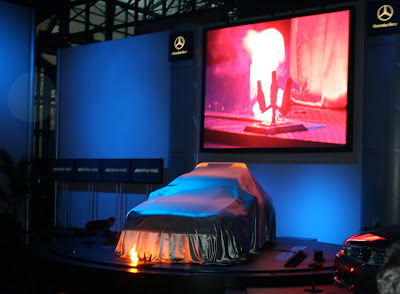











 PRESS RELEASE:
PRESS RELEASE:
